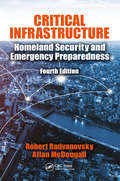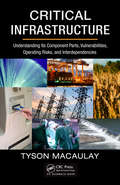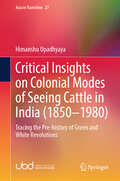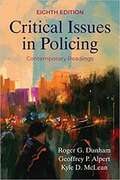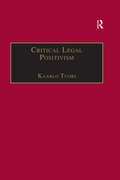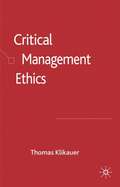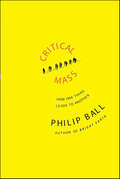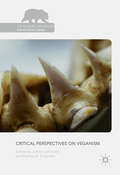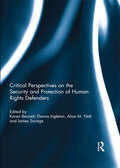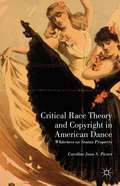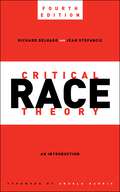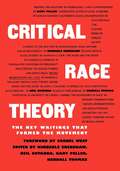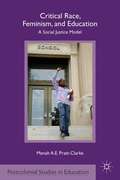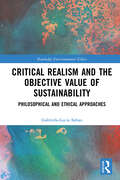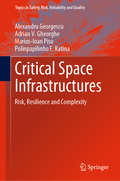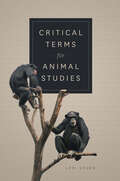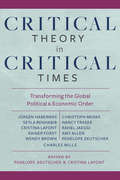- Table View
- List View
Critical Infrastructure: Homeland Security and Emergency Preparedness,
by Robert S. Radvanovsky Allan McDougallThis edition of Critical Infrastructure presents a culmination of ongoing research and real-work experience, building upon previous editions. Since the first edition of this work, the domain has seen significant evolutions in terms of operational needs, environmental challenges and threats – both emerging and evolving. This work expands upon the previous works and maintains its focus on those efforts vital to securing the safety and security of populations. The world continues to see a shift from a force-protection model to one more focused on resilience. This process has been exacerbated and challenged as societies face increased instability in weather and arguably climate, a destabilized geopolitical situation, and continuing economic instability. Various levels—ranging from international oversight to individual actions—continue to work towards new approaches and tools that can assist in meeting this challenge. This work keeps pace with the key changes that have occurred since previous editions and continues to provide insight into emerging and potential issues. Expanding from historical research, major areas of interest such as climate change, regulatory oversight, and internal capacity building are explored. This work provides a reference for those that are working to prepare themselves and their organizations for challenges likely to arise over the next decade. In keeping with the fast-changing nature of this field, Critical Infrastructure: Homeland Security and Emergency Preparedness, Fourth Edition has been completely revised and fully updated to reflect this shift in focus and to incorporate the latest developments. Presents an overview of some of the emerging challenges and conflicts between the public and private sector; Continues to build the case for organizations to adopt an intelligence-driven and adaptive approach to protecting infrastructure; Presents a unique and new perspective of re-examining baseline requirements against a range of shifting factors, taking a balanced approach between risk-based planning and consequence management; Expands upon the issue of internal and lone-wolf threats that pose additional challenges to a system that continues to focus largely on external threats; and An enhanced and improved view of interdependencies in an increasingly inter-connected and network-enabled world. Preparing for the challenges of increasingly unstable threat and operating environments will pose challenges at all levels. Those involved in ensuring that critical infrastructure protection and assurance efforts function effectively and efficiently—whether as government regulators, business operators, clients of various infrastructure sectors or those seeking to maintain an accountable system – will find insights into less-explored aspects of this challenging field.
Critical Infrastructure: Understanding Its Component Parts, Vulnerabilities, Operating Risks, and Interdependencies
by Tyson MacaulayCritical Infrastructure (CI) is fundamental to the functioning of a modern economy, and consequently, maintaining CI security is paramount. However, despite all the security technology available for threats and risks to CI, this crucial area often generates more fear than rational discussion. Apprehension unfortunately prompts many involved in CI p
Critical Insights on Colonial Modes of Seeing Cattle in India: Tracing the Pre-history of Green and White Revolutions (Asia in Transition #27)
by Himanshu UpadhyayaThis book traces the contours of the symbiotic relationship between crop cultivation and cattle rearing in India by reading against the grain of several official accounts from the late colonial period to the 1980s. It also skillfully unpacks the multiple cultural expressions that revolve around cattle in India and the wider subcontinent to show how this domestic animal has greatly impacted political discourses in South Asia from colonial times, into the postcolonial period. The author begins by demonstrating the dependence between the nomadic cattle breeder and the settled cultivator, at the nexus of land-livestock-agriculture, as indicated in the writings of Sir Albert Howard, who espoused some of the most sophisticated ideas on integration, holism, and mixed farming in an era when agricultural research was marked by increasing specialisation and compartmentalisation. The book springboards with the views of colonial experts who worked at imperial science institutions but passionately voiced dissenting opinions due to their emotional investment in the lives of Indian peasants, of whom Howard was a leading light. The book presents Howard and his contemporaries’ writings to then engage contemporary debates surrounding organic agriculture and climate change, tracing the path out of the treadmill of industrial agriculture and factory farming. In doing so, the book shows how, historically, animal rearing has been critically linked to livelihood strategies in the Indian subcontinent. At once a dispassionate reflection on the role played by cattle and water buffaloes in not just supporting farm operations in the agro-pastoral landscape, but also in contributing to millions of livelihoods in sustainable ways while fulfilling the animal protein in the Indian diet, the book presents contemporary lessons on development perspectives relating to sustainable and holistic agriculture. A rich and sweeping treatment of this aspect of environmental history in India that tackles the transformations prompted by the arrival of veterinary medicine, veterinary education and notions of scientific livestock management, the book is a rare read for historians, environmentalists, agriculturalists, development practitioners, and animal studies scholars with a particular interest in South Asia.
Critical Introduction to Law
by Wade Mansell Belinda Meteyard Alan ThomsonThis book challenges the usual introductions to the study of law. It argues that law is inherently political and reflects the interests of the few even while presenting itself as neutral. It considers law as ideology and as politics, and critically assesses its contribution to the creation and maintenance of a globalized and capitalist world. The clarity of the arguments are admirably suited to provoking discussions of the role of law in our contemporary world. This third edition provides contemporary examples to sustain the arguments in their relevance to the twenty-first century. The book includes an analysis of the common sense of law; the use of anthropological examples to gain external perspectives of our use and understanding of law; a consideration of central legal concepts, such as order, rules, property, dispute resolution, legitimation and the rule of law; an examination of the role of law in women's subordination and finally a critique of the effect of our understanding of law upon the wider world. This book is ideal for undergraduate and postgraduate students reading law.
Critical Issues in International Refugee Law
by James C. SimeonThis volume of essays examines key cutting edge areas of international refugee law, including strategies for interpretative harmony, the rights of refugees and the standard of proof in complementary protection. Each topic is examined from a theoretical and a practical perspective in order to find solutions to the many legal issues and concerns which currently confront this area of law, and to seek ways to advance the field as a whole.
Critical Issues in Policing: Contemporary Readings
by Geoffrey P. Alpert Roger G. Dunham Kyle D. McLeanThe eighth edition of this comprehensive collection includes carefully chosen articles with fresh perspectives on the most current trends in policing. Critical Issues in Policing provides ready access to the brightest minds in the field of policing. The 36 contributions sharpen understanding of the intricacies of police work and encourage readers to change from holding the police responsible for crime rates to holding them accountable for specific goals, tasks, and objectives. <P><P> The new edition continues its authoritative, insightful coverage of complex elements of policing and presents vivid and pragmatic illustrations of law enforcement issues. The anthology offers an alternative to traditional policing texts. It covers philosophies of policing that guide discussions about police culture, police misconduct, use of force, operational concerns, and technological innovations. Title of related interest available from Waveland Press: Katz-Maguire, Transforming the Police (ISBN 97814786).
Critical Issues in Restorative Justice
by Howard Zehr Barb ToewsThe contributors to this book critically examine restorative justice, identifying the main threats to its integrity and effectiveness. The ground that they cover ranges from victim, offender, and practitioner issues, to the role of the state, to broad questions of social justice.
Critical Legal Positivism (Applied Legal Philosophy)
by Kaarlo TuoriThis profound and scholarly treatise develops a critical version of legal positivism as the basis for modern legal scholarship. Departing from the formalism of Hart and Kelsen and blending the European tradition of Weber, Habermas and Foucault with the Anglo-American contributions of Dworkin and MacCormick, Tuori presents the normative and practical faces of law as a multilayered phenomenon within which there is an important role for critical legal dogmatics in furthering law's self-understanding and coherence. Its themes also resonate with importance for the development of the European legal system.
Critical Management Ethics
by Thomas KlikauerWritten in the European tradition of Kant's philosophical trilogy on critique and Hegel's concept of ethical life it outlines the great traditions in ethical philosophy: Aristotelian virtue ethics, Kantian ethics, and utilitarianism. It presents modern ethics from Nietzsche, Adorno, and Habermas to Kohlberg's stages of moral development.
Critical Mass: How One Thing Leads to Another
by Philip BallAre there any "laws of nature" that influence the ways in which humans behave and organize themselves? In the seventeenth century, tired of the civil war ravaging England, Thomas Hobbes decided that he would work out what kind of government was needed for a stable society. His approach was based not on utopian wishful thinking but rather on Galileo's mechanics to construct a theory of government from first principles. His solution is unappealing to today's society, yet Hobbes had sparked a new way of thinking about human behavior in looking for the "scientific" rules of society. Adam Smith, Immanuel Kant, Auguste Comte, and John Stuart Mill pursued this idea from different political perspectives. Little by little, however, social and political philosophy abandoned a "scientific" approach. Today, physics is enjoying a revival in the social, political and economic sciences. Ball shows how much we can understand of human behavior when we cease to try to predict and analyze the behavior of individuals and instead look to the impact of individual decisions-whether in circumstances of cooperation or conflict-can have on our laws, institutions and customs. Lively and compelling, Critical Mass is the first book to bring these new ideas together and to show how they fit within the broader historical context of a rational search for better ways to live.
Critical Perspectives on Coercive Interventions: Law, Medicine and Society (Routledge Frontiers of Criminal Justice)
by Adrian Carter Claire Spivakovsky Kate SeearCoercive medico-legal interventions are often employed to prevent people deemed to be unable to make competent decisions about their health, such as minors, people with mental illness, disability or problematic alcohol or other drug use, from harming themselves or others. These interventions can entail major curtailments of individuals’ liberty and bodily integrity, and may cause significant harm and distress. The use of coercive medico-legal interventions can also serve competing social interests that raise profound ethical, legal and clinical questions. Examining the ethical, social and legal issues involved in coerced care, this book brings together the views and insights of leading researchers from a range of disciplines, including criminology, law, ethics, psychology and public health, as well as legal and medical practitioners, social-service ‘consumers’ and government officials. Topics addressed in this volume include: compulsory treatment and involuntary detention orders in civil mental health and disability law; mandatory alcohol and drug treatment programs and drug courts; community treatment orders; the use of welfare cards with Indigenous populations; mandated treatment of seriously ill minors; as well as adult guardianship and substituted decision-making regimes. These contributions attempt to shed light on why we use coercive interventions, whether we should, whether they are effective in achieving the benefits that are offered to justify their use, and the impact that they have on some of society’s most vulnerable citizens in the names of ‘justice’ and ‘treatment’. This book is essential reading for clinicians, researchers and legal practitioners involved in the study and application of coerced care, as well as students and scholars in the fields of law, medicine, ethics and criminology. The collection asks important questions about the increasing use of coercive care that demand to be answered, and offers critical insights, guidance and recommendations for those working in the field.
Critical Perspectives on Veganism (The Palgrave Macmillan Animal Ethics Series)
by Jodey Castricano Rasmus R. SimonsenThis book examines the ethics, politics and aesthetics of veganism in contemporary culture and thought. Traditionally a lifestyle located on the margins of western culture, veganism has now been propelled into the mainstream, and as agribusiness grows animal issues are inextricably linked to environmental impact as well as to existing ethical concerns. This collection connects veganism to a range of topics including gender, sexuality, race, the law and popular culture. It explores how something as basic as one’s food choices continue to impact on the cultural, political, and philosophical discourse of the modern day, and asks whether the normalization of veganism strengthens or detracts from the radical impetus of its politics. With a Foreword by Melanie Joy and Jens Tuidor, this book analyzes the mounting prevalence of veganism as it appears in different cultural shifts and asks how veganism might be rethought and re-practised in the twenty-first century.
Critical Perspectives on the Security and Protection of Human Rights Defenders
by Karen Bennett, Danna Ingleton, Alice M. Nah and James SavageHuman rights defenders – who by peaceful means advocate, mobilise and often put their lives at risk to defend the most fundamental freedoms of their fellow citizens – are key agents of change in their own societies and make a significant contribution to the international community's efforts to support democracy and human rights. Defenders often face serious threats and can experience harm by state and non-state actors. Since the United Nations General Assembly's adoption of the Declaration on Human Rights Defenders in 1998, there has been considerable effort to recognise and protect the right of individuals, groups and communities to promote and protect their own rights and the rights of others. Over time, a multi-level, multi-actor international protection regime for the rights of human rights defenders has emerged, which is based on existing rights derived from the international human rights regime. The authors in this book reflect on the positive developments that have emerged over time to strengthen the protection of defenders, as well as the debates, tensions and contestations in such practices. This collection provides a critical appraisal of the construction, function, ethical boundaries, and evolution of this protection regime, as well as its multi-scalar social and political effects. In particular, the authors consider the effectiveness of particular international and regional protection mechanisms for the protection of defenders, and examine the relationship between repression, activism, and tactics for managing risks in the face of danger. This book was originally published as a special issue of the International Journal of Human Rights.
Critical Race Judgments: Rewritten U.S. Court Opinions on Race and the Law
by Devon W. Carbado Angela Onwuachi-Willig Bennett Capers R. A. LenhardtBy re-writing US Supreme Court opinions that implicate critical dimensions of racial justice, Critical Race Judgments demonstrates that it's possible to be judge and a critical race theorist. Specific issues covered in these cases include the death penalty, employment, voting, policing, education, the environment, justice, housing, immigration, sexual orientation, segregation, and mass incarceration. While some rewritten cases – Plessy v. Ferguson (which constitutionalized Jim Crow) and Korematsu v. United States (which constitutionalized internment) – originally focused on race, many of the rewritten opinions – Lawrence v. Texas (which constitutionalized sodomy laws) and Roe v. Wade (which constitutionalized a woman's right to choose) – are used to incorporate racial justice principles in novel and important ways. This work is essential for everyone who needs to understand why critical race theory must be deployed in constitutional law to uphold and advance racial justice principles that are foundational to US democracy.
Critical Race Theory And Copyright In American Dance
by Caroline Joan S. PicartThe effort to win federal protection for dance in the United States was a racialized and gendered contest. Picart traces the evolution of choreographic works from being federally non-copyrightable to becoming a category potentially copyrightable under the 1976 Copyright Act, specifically examining Lo#65533;e Fuller, George Balanchine, and Martha Graham.
Critical Race Theory, Fourth Edition: An Introduction (Critical America #87)
by Richard Delgado Jean StefancicA new edition of a seminal text in Critical Race TheorySince the publication of the third edition of Critical Race Theory: An Introduction in 2017, the United States has experienced a dramatic increase in racially motivated mass shootings and a pandemic that revealed how deeply entrenched medical racism is and how public disasters disproportionately affect minority communities. We have also seen a sharp backlash against Critical Race Theory, and a president who deemed racism a thing of the past while he fanned the flames of racial intolerance and promoted nativist sentiments among his followers. Now more than ever, the racial disparities in all aspects ofpublic life are glaringly obvious. Taking note of all these developments, this fourth edition covers a range of new topics and events and addresses the rise of a fierce wave of criticism from right-wing websites, think tanks, and foundations, some of which insist that America is now colorblind and has little use for racial analysis and study. Award-winning authors Richard Delgado and Jean Stefancic also address the rise in legislative efforts to curtail K–12 teaching of racial history. Critical Race Theory, Fourth Edition, is essential for understanding developments in this burgeoning field, which has spread to other disciplines and countries. The new edition also covers the ways in which other societies and disciplines adapt its teachings and, for readers wanting to advance a progressive race agenda, includes new readings and questions for discussion aimed at outlining practical steps to achieve this objective.
Critical Race Theory: An Introduction
by Richard Delgado Jean StefancicThe authors have developed a primer that will give the reader an exploration of Critical Race Theory.
Critical Race Theory: An Introduction (Critical America #20)
by Richard Delgado Jean Stefancic Angela HarrisUpdated to include the Black Lives Matter movement, the presidency of Barack Obama, the rise of hate speech on the Internet, and more. <p><p>Since the publication of the first edition of Critical Race Theory in 2001, the United States has lived through two economic downturns, an outbreak of terrorism, and the onset of an epidemic of hate directed against immigrants, especially undocumented Latinos and Middle Eastern people. On a more hopeful note, the country elected and re-elected its first black president and has witnessed the impressive advance of gay rights. <p><p>As a field, critical race theory has taken note of all these developments, and this primer does so as well. It not only covers a range of emerging new topics and events, it also addresses the rise of a fierce wave of criticism from right-wing websites, think tanks, and foundations, some of which insist that America is now colorblind and has little use for racial analysis and study. <p><p>Critical Race Theory is essential for understanding developments in this burgeoning field, which has spread to other disciplines and countries. The new edition also covers the ways in which other societies and disciplines adapt its teachings and, for readers wanting to advance a progressive race agenda, includes new questions for discussion, aimed at outlining practical steps to achieve this objective.
Critical Race Theory: An Introduction (Second Edition)
by Richard Delgado Jean StefancicIn 2001, Richard Delgado and Jean Stefancic published their definitive Critical Race Theory, a compact introduction to the field that explained, in straightforward language, the origins, principal themes, leading voices, and new directions of this important movement in legal thought. Since then, critical race theory has gone on to influence numerous other fields of scholarship, and the Delgado and Stefancic primer has remained an indispensible guide for students and teachers. Delgado and Stefancic have revised the book to include material on key issues such as colorblind jurisprudence, Latino-Critical scholarship, immigration, and the rollback of affirmative action. This second edition introduces readers to important new voices in fields outside of law, including education and psychology, and offers greatly expanded issues for discussion, updated reading lists, and an extensive glossary of terms.
Critical Race Theory: The Key Writings That Formed The Movement
by Cornel West Kimberle Crenshaw Neil Gotanda Garry Peller Kendall ThomasIn the past few years, a new generation of progressive intellectuals has dramatically transformed how law, race, and racial power are understood and discussed in America. Questioning the old assumptions of both liberals and conservatives with respect to the goals and the means of traditional civil rights reform, critical race theorists have presented new paradigms for understanding racial injustice and new ways of seeing the links between race, gender, sexual orientation, and class. This reader, edited by the principal founders and leading theoreticians of the critical race theory movement, gathers together for the first time the movement's most important essays.
Critical Race, Feminism, and Education
by Menah A.E. Pratt-ClarkeCritical Race, Feminism, and Education provides a transformative next step in the evolution of critical race and Black feminist scholarship. Focusing on praxis, the relationship between the construction of race, class, and gender categories and social justice outcomes is analyzed. An applied transdisciplinary model - integrating law, sociology, history, and social movement theory - demonstrates how marginalized groups are oppressed by ideologies of power and privilege in the legal system, the education system, and the media. Pratt-Clarke documents the effects of racism, patriarchy, classism, and nationalism on Black females and males in the single-sex school debate.
Critical Realism and the Objective Value of Sustainability: Philosophical and Ethical Approaches (Routledge Environmental Ethics)
by Gabriela-Lucia SabauCritical Realism and the Objective Value of Sustainability contributes to the growing discussion surrounding the concept of sustainability, using a critical realist approach within a transdisciplinary theoretical framework to examine how sustainability objectively occurs in the natural world and in society. The book develops an ethical theory of sustainability as an objective value, rooted not in humans’ subjective preferences but in the holistic web of relationships, interdependencies, and obligations existing among living things on Earth, a web believed to have maintained life on Earth over the last 3.7 billion years. It proposes three pillars of sustainability ethics: contentment for the human existence given to us; justice (beyond distributive justice); and meaningful freedom (within ecological and moral limits). Using abductive reasoning, the book infers that there is an out-of-this-world Sustainer behind the Earth’s sustainability acting as a metaphysical source of all being and value. It argues that sustainability value, accepted as a shared understanding of the common good, must guide individual decisions and socio-economic development efforts as a matter of deliberate choice, as well as be built on the awareness that there are non-negotiable, pre-established conditions for our planet’s sustainability. This book will be of interest to students and scholars across fields of inquiry, including sustainability, sustainable development, environmental philosophy and ethics, philosophy of science, and ecological economics, and to whoever may wonder why seasons exists and why humans have creative minds.
Critical Space Infrastructures: Risk, Resilience and Complexity (Topics in Safety, Risk, Reliability and Quality #36)
by Adrian V. Gheorghe Polinpapilinho F. Katina Alexandru Georgescu Marius-Ioan PisoThis book introduces readers to the topical area of CSI: critical space infrastructure, which is defined as an emerging domain of systems-of-systems encompassing hardware, workforce, environment, facilities, business and organizational entities. Further, it includes unmanned air systems, satellites, rockets, space probes, and orbital stations, and involves multi-directional interactions essential for maintenance of vital societal functions (i.e., health, safety, economic and social well-being), the loss or disruption of which would have significant impact on virtually any nation. The topics covered include the main elements of CSI, CSI taxonomy, effects of CSI on other infrastructure systems, establishing quantitative and qualitative parameters, global and national effects of CSI failure, cascading disruptive phenomena, chilling effects in various fields, CSI protection, deliberate threats to space systems (e.g., electromagnetic pulse attacks), space governance, and a path forward for CSI research. Modern society is highly dependent on the continuous operation of critical infrastructure systems for the supply of crucial goods and services including, among others, the power supply, drinking water supply, and transportation systems; yet space systems – which are critical enablers for several commercial, scientific and military applications – are rarely discussed. This book addresses this gap.
Critical Terms for Animal Studies (Critical Terms)
by Lori GruenAnimal Studies is a rapidly growing interdisciplinary field devoted to examining, understanding, and critically evaluating the complex relationships between humans and other animals. Scholarship in Animal Studies draws on a variety of methodologies to explore these multi-faceted relationships in order to help us understand the ways in which other animals figure in our lives and we in theirs. Bringing together the work of a group of internationally distinguished scholars, the contribution in Critical Terms for Animal Studies offers distinct voices and diverse perspectives, exploring significant concepts and asking important questions. How do we take non-human animals seriously, not simply as metaphors for human endeavors, but as subjects themselves? What do we mean by anthropocentrism, captivity, empathy, sanctuary, and vulnerability, and what work do these and other critical terms do in Animal Studies? Sure to become an indispensable reference for the field, Critical Terms for Animal Studies not only provides a framework for thinking about animals as subjects of their own experiences, but also serves as a touchstone to help us think differently about our conceptions of what it means to be human, and the impact human activities have on the more than human world.
Critical Theory in Critical Times: Transforming the Global Political and Economic Order (New Directions in Critical Theory #7)
by Cristina Lafont Penelope DeutscherWe live in critical times. We face a global crisis in economics and finance, a global ecological crisis, and a constant barrage of international disputes. Perhaps most dishearteningly, there seems to be little faith in our ability to address such difficult problems. However, there is also a more positive sense in which these are critical times. The world's current state of flux gives us a unique window of opportunity for shaping a new international order that will allow us to cope with current and future global crises.In Critical Theory in Critical Times, eleven of the most distinguished critical theorists offer new perspectives on recent crises and transformations of the global political and economic order. Essays from Jürgen Habermas, Seyla Benhabib, Cristina Lafont, Rainer Forst, Wendy Brown, Christoph Menke, Nancy Fraser, Rahel Jaeggi, Amy Allen, Penelope Deutscher, and Charles Mills address pressing issues including international human rights and democratic sovereignty, global neoliberalism, novel approaches to the critique of capitalism, critical theory's Eurocentric heritage, and new directions offered by critical race theory and postcolonial studies. Sharpening the conceptual tools of critical theory, the contributors to Critical Theory in Critical Times reveal new ways of expanding the diverse traditions of the Frankfurt School in response to some of the most urgent and important challenges of our times.
